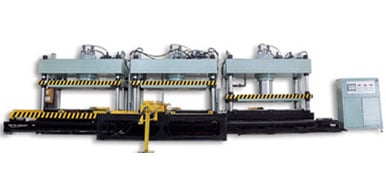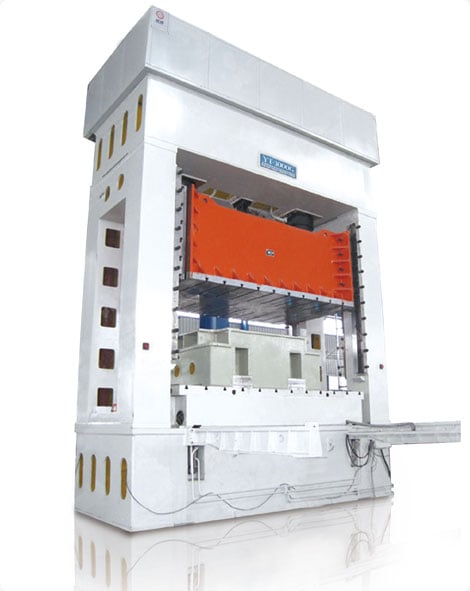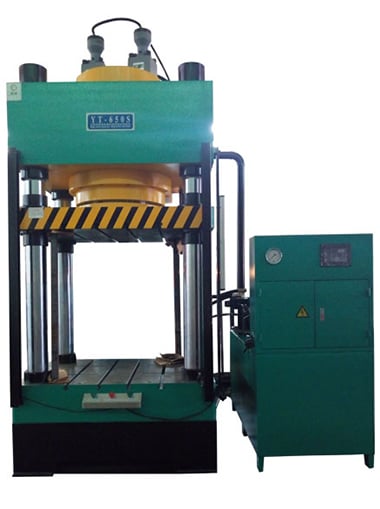How to Repair Hydraulic Presses
time:2023-05-27 views:(点击 919 次)
Your manufacturing business relies on hydraulic presses for shaping metal components, so any downtime or productivity loss must be kept to an absolute minimum. Preventive maintenance inspections can help ensure your hydraulic press runs at its optimum performance levels.
Here are three issues to look out for and how you can solve them.
1. Check the Pressure
Hydraulic presses can be an invaluable asset when applied with pressure; their versatility allows for numerous uses in many different situations. Unfortunately, however, sometimes they fail to function as intended due to any number of reasons; knowing how to check and repair this machine is therefore vitally important.
Before doing anything else, ensure that the hydraulic system is producing enough pressure. Too little pressure could impede its functions; therefore it's vitally important that this is checked on frequently.
Too much pressure can damage a hydraulic system and cause it to overheat, so to reduce risks it is crucial that temperatures in this system stay as low as possible.
Piston oil seal leaks are another common occurrence and can be caused by any number of issues such as an overfilled reservoir, contaminated check balls or worn piston packing. Preventative measures should include regularly inspecting and cleaning or replacing these components to maintain peak performance.
2. Check the Oil
As with any piece of machinery, hydraulic presses require regular oil replacement. Otherwise, their properties could deteriorate over time and render them inoperable - potentially jeopardizing performance and increasing cost for users.
Check if the piston oil seal is leaking; this could be caused by an overfilled oil reservoir, contaminated check ball, worn packing material or simply excessive wear-and-tear damage. In many instances, this problem can be addressed by taking steps such as removing and cleaning/replacing piston packing before installing new ones.
Lubricate guided platens regularly. Graphite or grease should be used, depending on the press manual's specific lubrication requirements for your particular model, to prevent unnecessary wear and tear on your hydraulic press, which in turn helps extend its service life and save on costly repairs in the future. A small investment will keep it working well!
3. Check the Electrical Connection
If your hydraulic press is leaking hydraulic fluid, this could indicate issues with its seals. Make sure all seals are intact and unclogged with debris.
Oil leaks not only create an unsightly mess, but they also pose a fire hazard. Press oil is highly pressurized and extremely hot; should it hit an open flame or other source of heat it could ignite.
Over time, a hydraulic press's ram may become damaged from wear-and-tear due to abrasion or general wear and tear, leading to cracks or leaks from its cylinder rod or bushings.
MPPS can design and manufacture new bushes, seals and gland systems to restore these presses to like-new condition, including removing the rams for remachining and fitting the new parts. We can also assist you in setting up a preventative maintenance inspection program for both manual and automatic models of presses.
4. Check the Cylinders
Hydraulic press cylinders are integral to productivity, so when they malfunction it's crucial that they're repaired promptly and correctly. Unfortunately, the repair process can be complex due to many parts that must be tightened properly or replaced altogether - this requires great care in fixing these hydraulic cylinders correctly, so professional assistance may be best used in performing this service.
Damaged seals on cylinders can have a dramatic impact on how they operate, so it's vital to conduct regular checks of both rod and piston for signs of wear, seals themselves, as well as their interior surfaces for scratches or any signs of damage.
After disassembling a cylinder, it is critical to thoroughly clean its rod and piston by wiping away any dirt or grease build-up, then reassemble. Be sure to fasten any removed guards back in their proper places as soon as you reassemble your new hydraulic cylinder and bleed its hydraulic system (if it features test couplings). Finally, test its new condition between home and work positions until its movement is smooth without any air entering its chambers.
Link to this article: https://www.ihydraulicpress.com/mk/3206.html
Hot Articles
-
How to Manufacture Hydraulic Presses
A hydraulic press is a machine that employs pressure (according to Pascal’s Law) to deform materials. It comprises many components which wor……
-
How to Add a Pressure Gauge to a Hydraulic Press
Pressure gauges are used to monitor hydraulic system pressure. There are various forms, but the most popular gauge design is known as a Bourdon tu……
-
Using a Hydraulic Press for Hydraulic Hose Repair
Hydraulic hoses are an integral component of many heavy-duty machinery systems. If they fail, it can result in decreased productivity, higher repair……
-
How to Load Steel Into a Schuler Hydraulic Press
Schuler offers systems, tools and dies, process expertise and services for the entire metalworking industry. Our automation solutions enhance prod……
-
How to Make a Hydraulic Press for Jewelry
Discover new technologies involving a hydraulic press that save time and tooling costs when producing jewelry. These methods range from sheet meta……
-
How Do Hydraulic Presses Help With Building Or Construction?
Hydraulic presses use hydraulic fluid to generate and transfer force. The fluid is contained within an elaborate system of pipes and cylinders; when……
-
How to Build an Electric Hydraulic Press
Hydraulic presses can create immense pressure for metal forming, powder compaction and other purposes. This Potter USA electric hydraulic press co……
-
Hydraulic Press for Hydraulic Motor Repair
Hydraulic presses are indispensable machine tools that can help small shops, auto repair shops, or parts fabrication businesses increase productivit……
Latest News
-
How to Build a Hydraulic Press Plans
Hydraulic presses are versatile machines capable of performing various types of jobs. Utilizing a pump and cylinder filled with hydraulic oil to p……
-
Can a Hydraulic Press Crush Carbon Into a Diamond?
Hydraulic Press Channel have used their industrial-sized hydraulic press to crush various things on YouTube, including this time using it on a 1.2……
-
How Do I Work a Hydraulic Press?
Hydraulic presses are essential tools in many industrial environments, yet can also be hazardous if misused improperly. Proper operation requires ……
-
Hydraulic Press For Vermicomposting
Hydraulic presses are employed in a variety of industries. They have the capacity to compress, assemble, draw, punch, trim, stretch, stamp and form ……
-
Does a Hydraulic Press Have Hydraulic Fluid?
Hydraulic presses come in all shapes and sizes, from table top models to huge machines capable of exerting hundreds of tons of force. All hydraulic……
-
How is Hydraulic Press Capacity Calculated?
Hydraulic presses can apply large amounts of force to mold metal parts. The amount required depends on both the material being formed and its ener……
-
Can You Crush a Diamond With a Hydraulic Press?
Diamonds may be one of the hardest materials on Earth, yet they can still be broken by even standard hammers if hit hard enough. The Hydraulic Pre……
-
How to Make a Hydraulic Press at Home
Hydraulic presses are machines that utilize a cylinder to generate high levels of force. They’re commonly employed for metal forming and bendi……














































